- Joined
- Nov 26, 2005
- Messages
- 5,260
- Reaction score
- 11,104
Hi,
I haven't posted much in a while because I am struggling with shingles and have some good but many bad days. This is the result of a good day. It is an excerpt from a comprehensive tutorial I am doing on building an historically correct English fowler on another forum. Inletting the barrel keys is a task that gives a lot of folk's heartburn. With the right technique, it is not hard to do. Here I show how I do it in this case with a barrel set up using barrel bands rather than dovetailed or soldered lugs. Bands were often used when British gunmakers were mounting fine thin-walled Spanish barrels. My method is the same if you use soldered lugs. The first step is to inlet the barrel lugs into the stock. This was easy, however the thin web of wood between the barrel and ramrod will result in the bottom of the lug showing in the ramrod channel. That is how my original gun is made so I am not concerned. Some folks object but I would rather have a very slim fowler than worry about lugs showing in the ramrod channel.
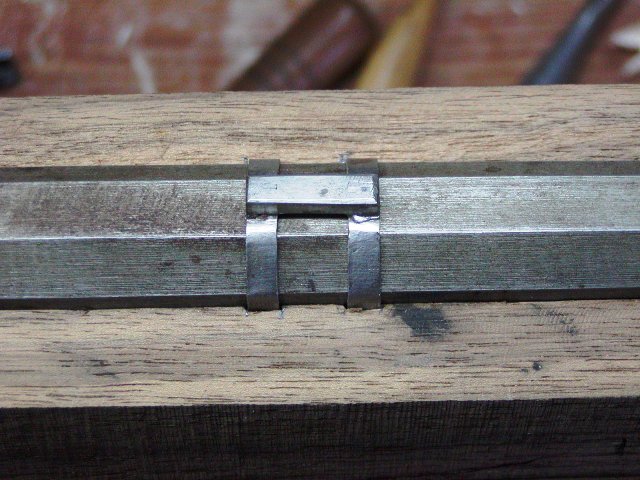
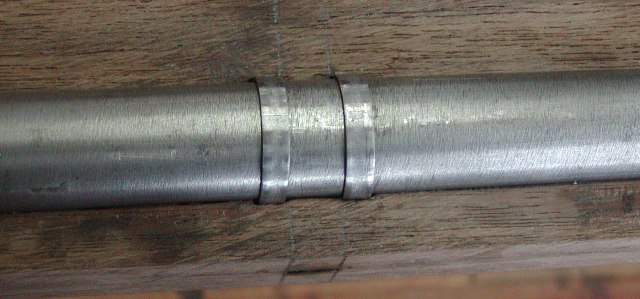
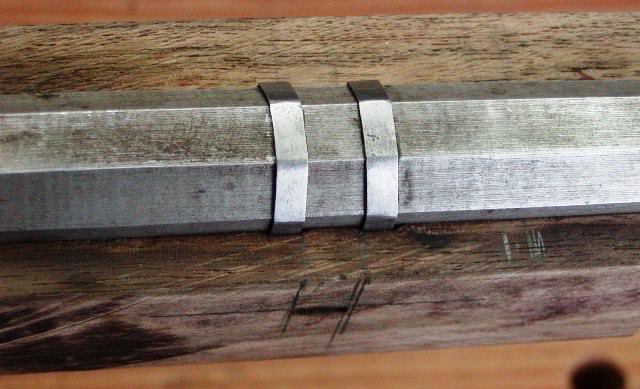
The key slots must be accurately positioned so it is important that they are precisely marked on the sides of the stock. Prior to doing this task I make sure the sides and top of the barrel channel are squared up. Then I measure the diameter of the barrel at the location of a key, measure that distance down on both sides of the stock. Next, using the barrel bands, I mark lines on both sides of the stock showing the width of the slot. In the photo below the slot is cut but is shows the marking lines.
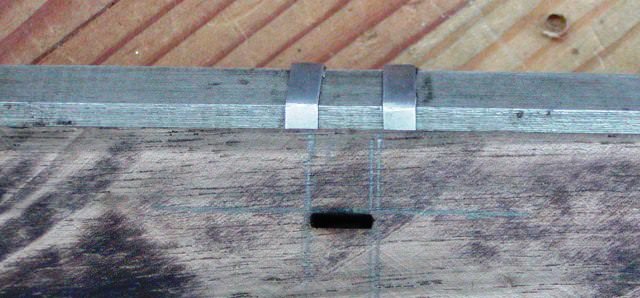
Once marked, and checked, and rechecked, I punch 3 horizontal lined up holes into both sides of the stock that are a little under sized for the barrel key. Using my drill press, I drill those holes from both sides of the stock. I then use a chisel made from a flat needle file to cut wood away between the 3 holes. The file tip is shaped and sharpened like a skew chisel. You have to be gentle because the file is brittle but with a sharp edge, it will cut through the wood quickly. Once I break into the inlet for the barrel lug, I switch sides and do the same from the other side. Then to widen the slot, which is undersized, I use a piece of fret saw blade that has been broken off to a short length and the end ground to a point. It is placed in a handle used for X-Acto blades and oriented so it cuts on the pull stroke. I then use the saw to cut the slot wider.
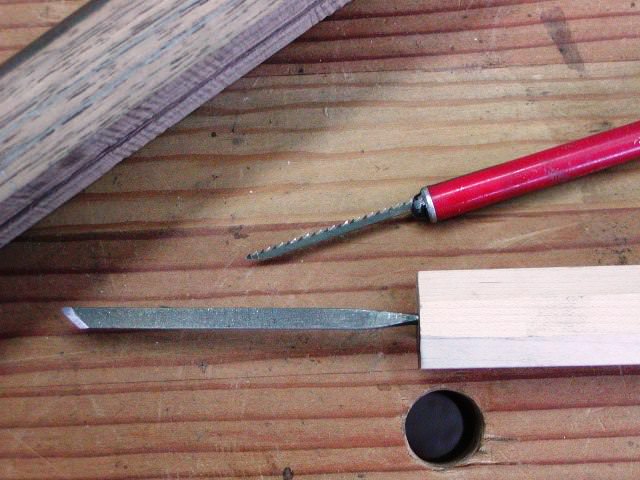
Once cut to the correct width, I use the flat needle file chisel to clean up the slot a bit before burning in the final fit. I shape the end of a barrel key into a chisel point, hold it with pliers, and heat it with a mini torch. When it is a bit beyond blue, I insert it into the slot and allow it to burn its way into the stock. Don't wiggle it, just let it burn in. On British guns, barrel keys are inserted from the side opposite the lock. Always. I don't care if on some Hawken or American guns they are inserted from the lock side. On British guns the heads are on the side plate side. Burn the key through the stock from the direction they will be inserted. That will assure the slot opening on the lock side does not get burned wider than the key and any slop on the side of insertion is hidden under the head of the key.
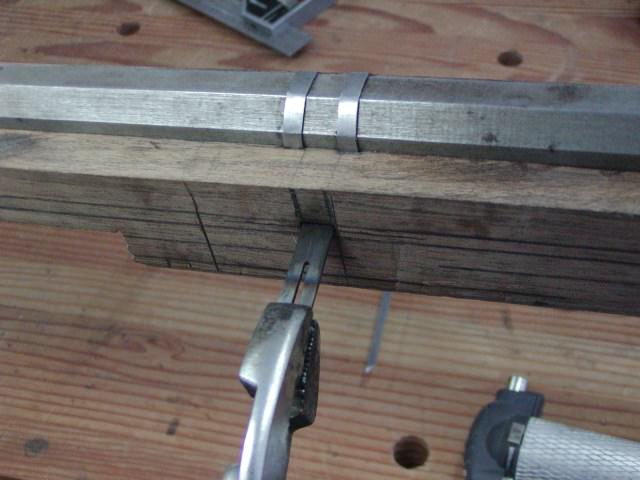
If you are careful, a perfect barrel key slot is the result.
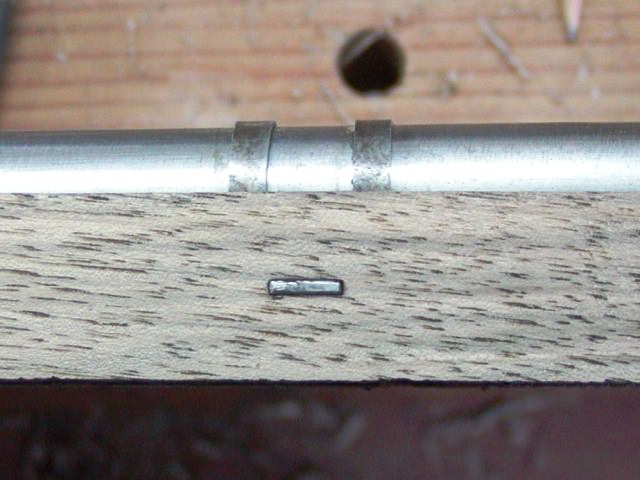
dave
I haven't posted much in a while because I am struggling with shingles and have some good but many bad days. This is the result of a good day. It is an excerpt from a comprehensive tutorial I am doing on building an historically correct English fowler on another forum. Inletting the barrel keys is a task that gives a lot of folk's heartburn. With the right technique, it is not hard to do. Here I show how I do it in this case with a barrel set up using barrel bands rather than dovetailed or soldered lugs. Bands were often used when British gunmakers were mounting fine thin-walled Spanish barrels. My method is the same if you use soldered lugs. The first step is to inlet the barrel lugs into the stock. This was easy, however the thin web of wood between the barrel and ramrod will result in the bottom of the lug showing in the ramrod channel. That is how my original gun is made so I am not concerned. Some folks object but I would rather have a very slim fowler than worry about lugs showing in the ramrod channel.



The key slots must be accurately positioned so it is important that they are precisely marked on the sides of the stock. Prior to doing this task I make sure the sides and top of the barrel channel are squared up. Then I measure the diameter of the barrel at the location of a key, measure that distance down on both sides of the stock. Next, using the barrel bands, I mark lines on both sides of the stock showing the width of the slot. In the photo below the slot is cut but is shows the marking lines.

Once marked, and checked, and rechecked, I punch 3 horizontal lined up holes into both sides of the stock that are a little under sized for the barrel key. Using my drill press, I drill those holes from both sides of the stock. I then use a chisel made from a flat needle file to cut wood away between the 3 holes. The file tip is shaped and sharpened like a skew chisel. You have to be gentle because the file is brittle but with a sharp edge, it will cut through the wood quickly. Once I break into the inlet for the barrel lug, I switch sides and do the same from the other side. Then to widen the slot, which is undersized, I use a piece of fret saw blade that has been broken off to a short length and the end ground to a point. It is placed in a handle used for X-Acto blades and oriented so it cuts on the pull stroke. I then use the saw to cut the slot wider.

Once cut to the correct width, I use the flat needle file chisel to clean up the slot a bit before burning in the final fit. I shape the end of a barrel key into a chisel point, hold it with pliers, and heat it with a mini torch. When it is a bit beyond blue, I insert it into the slot and allow it to burn its way into the stock. Don't wiggle it, just let it burn in. On British guns, barrel keys are inserted from the side opposite the lock. Always. I don't care if on some Hawken or American guns they are inserted from the lock side. On British guns the heads are on the side plate side. Burn the key through the stock from the direction they will be inserted. That will assure the slot opening on the lock side does not get burned wider than the key and any slop on the side of insertion is hidden under the head of the key.

If you are careful, a perfect barrel key slot is the result.

dave




